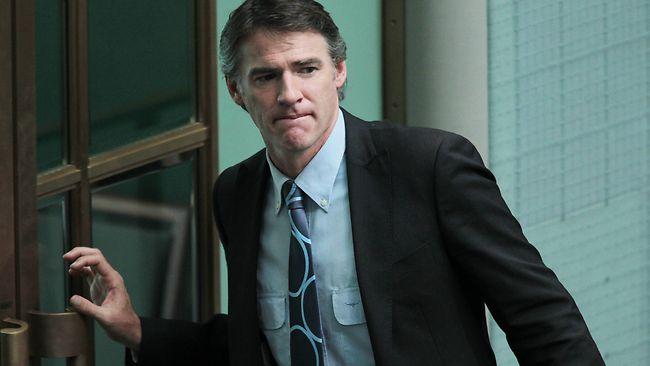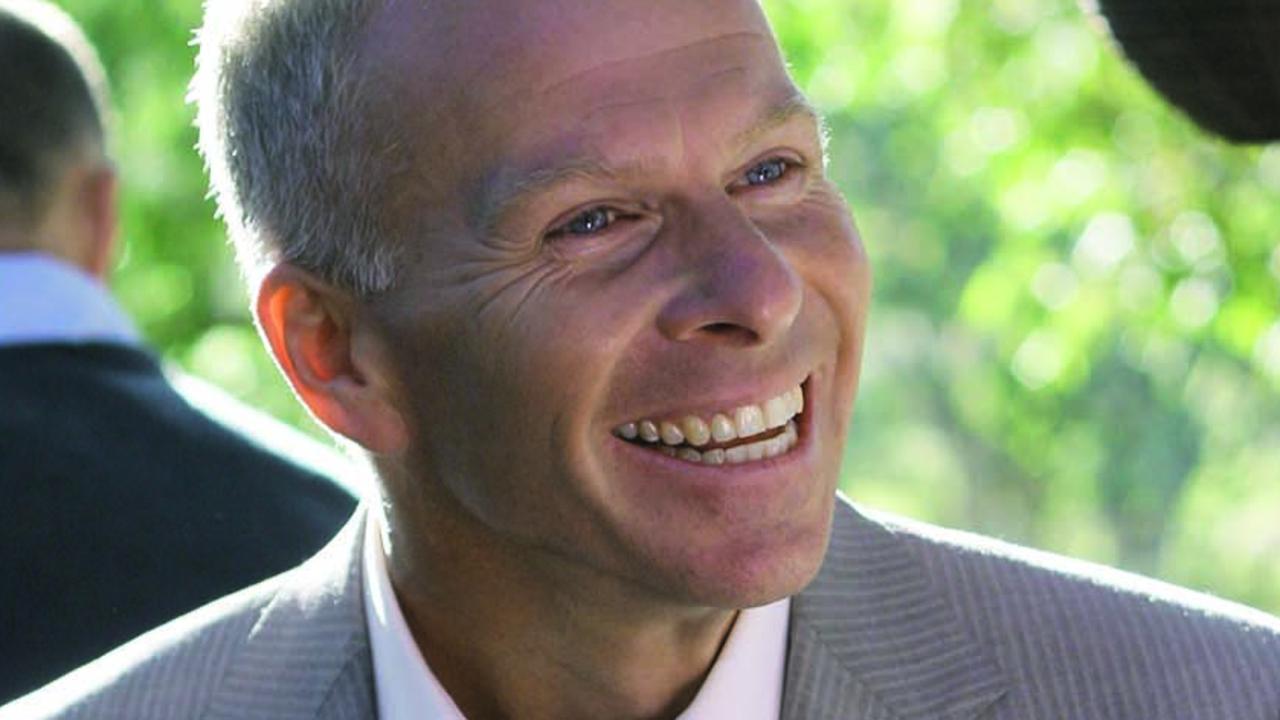Rob Oakeshott 'intervened' for campaign donor in toxic waste dumping case
ROB Oakeshott intervened in a government investigation on behalf of a campaign donor accused of dumping thousands of tonnes of contaminated waste.

ROB Oakeshott intervened in a government investigation on behalf of a campaign donor accused of dumping thousands of tonnes of contaminated waste.
The independent MP's intervention, which allegedly included meetings with officials and a potential witness, came after the NSW Environmental Protection Agency launched an investigation in 2006 into the dumping of up to 10,000 tonnes of waste containing the toxic biocide tributyltin, or TBT.
The waste was allegedly dumped over a period of years by the then Birdon Group, a shipbuilding, repair and dredging business based at Port Macquarie, in Oakeshott's Lyne electorate on the NSW mid-north coast.
At the time of the investigation, the director and owner of the company was local businessman Jim Bruce, who helped run Oakeshott's state campaign in 2003 and whose company made several contributions to his state election campaigns.
Oakeshott, who lobbied for Birdon during his talks with Julia Gillard and Tony Abbott after the August election, confirmed to The Australian he had become involved in helping to resolve the "complex constituent issue".
Former Birdon Group director Russell Byrne said Oakeshott's involvement included attending a meeting with the EPA's star witness, who was a former senior manager from the company. And Mr Byrne claimed that as a result of the meeting, the witness, who had already given a statement to the EPA, did not further "agitate" over the allegations of dumping.
The case never progressed after the EPA board voted in 2008 to drop the proposed "tier one" prosecution -- which carried a potential fine of up to $1 million for corporations or a jail term for individuals if found guilty -- after the authority received external legal advice that it would not be successful. No lesser charges could then be brought because the statute of limitations had expired, sources have told The Australian. But the tonnes of anti-fouling waste -- a by-product from the sand-blasting process used to clean boat hulls -- are still on the banks of the Hastings River and TBT has been found
in the waterway near the Birdon site, about 9km west of Port Macquarie.
And while the EPA continues to negotiate a clean-up with the management of the company -- Jim Bruce died in 2008 -- locals remain concerned about the potential impact of TBT on marine life, particularly the region's famed oyster beds. The chemical, which is embedded in paint on boat hulls to kill molluscs such as barnacles, has been banned internationally since 2003 because it can be toxic to shellfish such as oysters and sea snails and concentrations can build up in other species of fish. Its disposal has been regulated for decades.
"I and many other oyster farmers, professional fisherman and community members have worked for over 15 years to have gross pollution of the Hastings River addressed," says retired oyster farmer Laurie Lardner.
"If the local community was aware of the extent of the pollution from TBT and its impact on the marine environment, there would rightly be outrage."
Lardner, one of the few locals with detailed knowledge of the Birdon case, claims the EPA and the Port Macquarie Hastings Council, which has in the past said the waterways were worth $1.4 billion to the local community, have not done enough.
A joint study of the Hastings River by NSW Environment Department and Central Queensland University scientists last year found evidence of TBT contamination in the water and in marine organisms. "The contaminated sand-blasting waste provided a source of bio-available TBT for a wide area of the Hastings River," the study said, noting TBT absorption signs in female oysters that had started to grow male sex organs.
Research conducted overseas in the past two years has also suggested the chemical could cause obesity in humans by adversely affecting fat cells.
Oakeshott confirmed to The Australian he had been involved in "pushing for action" over the waste case. Asked last week for details of any meetings he might have had with any potential witnesses to the case, bureaucrats or politicians, he refused to comment and issued only a general statement.
"If anyone has any allegations regarding any aspect of my involvement, there are appropriate formal channels for such allegations to be made, and I would encourage them to do so," he said.
He said the matter had been a "complex constituent issue" involving Birdon, the NSW EPA and the body's legal branch.
"Fundamentally, the concern was that a 'clean-up order' was not being presented to the firm in question whilst potential legal action from government was being pursued separately regarding on-site contaminates," he said.
Oakeshott said he became involved only after the "matter had been stalled with government for 12 months, meaning local environment, local economy and government all suffer".
"My actions were to push for action -- either a prosecution or a site remediation plan," he said. "Essentially, I was advocating a decision that all parties could move with certainty."
Byrne, a lawyer who was a Sydney-based director of the company in 1993-98, told The Australian he was present at a NSW Parliament House meeting with Oakeshott, Birdon representatives and the EPA witness.
Byrne, who remains concerned about the failure to clean up the allegedly contaminated site, said Oakeshott had been well-intentioned and conducted himself appropriately in arranging and attending the meeting.
He claimed Oakeshott tried to broker a deal between the witness and the representatives of Birdon, calling on them to stop making negative claims about their business operations. And he claimed that as a result of the meeting, the witness, who does not want to be named, agreed to stop agitating over the allegations of dumping.
The EPA has confirmed Oakeshott was present at a separate meeting it held with the Port Macquarie Hastings Council about the issue "in 2005-06" but did not provide further details. It also refused to release the legal advice given to its board.
There is no suggestion Oakeshott, who shifted to federal parliament in 2008 and now holds the balance of power with two other independent MPs, had anything to do with the external legal advice to the board.
Birdon, which has been operating in the Port Macquarie region for 30 years, has rejected any suggestion it acted inappropriately in relation to the waste. It is understood to have claimed the waste was disposed of appropriately.
Birdon's current managing director, Jamie Bruce, who took over after the death of his father in 2008, has declined to discuss whether he met with Oakeshott about the waste.
Oakeshott has had a long association with Jim Bruce and Birdon, which he attributes to the fact the company is a major employer in his electorate.
Through his company, Jim Bruce handed more than $11,630 to Oakeshott's 2003 campaign, the largest single donation by a corporation or individual, according to electoral funding records. Birdon donated $4500 to Oakeshott's 2007 campaign, and Bruce's wife, Dawn, has worked in Oakeshott's Port Macquarie electorate office. Birdon contributed $4500 to Oakeshott's 2010 federal campaign. Oakeshott is listed as a trustee along with Jamie Bruce on the Jim Bruce Urology and Prostate Cancer Trust. The trust's website says of the trustees that "through various walks of life, each of these gentlemen had a long association with Jim".
As recently as July, NSW health officials wrote to the Port Macquarie Hastings Council noting that TBT had been found in the groundwater in and around the Birdon site and recommended further testing in case it had polluted local bores tapped for domestic use.
But Port Macquarie Hastings Council manager Matt Rogers last week played down the concerns, saying council testing had not found evidence of the contamination spreading outside the site or polluting bores.
He said further testing was being undertaken.
Earlier this year, the Birdon Group put forward a plan to move TBT-contaminated waste to the local dump. The Port Macquarie Hastings Council agreed to accept the waste subject to the plan being approved by the EPA, but the EPA rejected the plan because it did not provide a high level of protection for the site, which is also on the banks of the Hastings River. It is currently negotiating with the company over another remediation plan.
Former Port Macquarie Hastings councillor Lisa Intemann, who raised concerns about the material on the site in 2008, says she is "gravely disappointed that the system could not work to protect the community and its environment".


